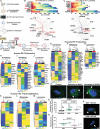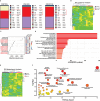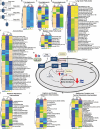This is a preprint.
Glycoprotein 130 Antagonism Counteracts Metabolic and Inflammatory Alterations to Enhance Right Ventricle Function in Pulmonary Artery Banded Pigs
- PMID: 39896622
- PMCID: PMC11785131
- DOI: 10.1101/2025.01.20.633954
Glycoprotein 130 Antagonism Counteracts Metabolic and Inflammatory Alterations to Enhance Right Ventricle Function in Pulmonary Artery Banded Pigs
Abstract
Background: Right ventricular dysfunction (RVD) is a risk factor for death in multiple cardiovascular diseases, but RV-enhancing therapies are lacking. Inhibition of glycoprotein-130 (GP130) signaling with the small molecule SC144 improves RV function in rodent RVD via anti-inflammatory and metabolic mechanisms. However, SC144's efficacy and molecular effects in a translational large animal model of RVD are unknown.
Methods: 4-week-old castrated male pigs underwent pulmonary artery banding (PAB). After 3 weeks, PAB pigs were randomized into 2 groups (daily injections of SC144 [2.2 mg/kg, PAB-SC144, n=5] or vehicle [PAB-Veh, n=5] for 3 weeks). Five age-matched pigs served as controls. Cardiac MRI quantified RV size/function. Right heart catheterization evaluated hemodynamics. Single-nucleus RNA sequencing delineated cell-type specific changes between experimental groups. Electron microscopy evaluated RV mitochondrial morphology. Phosphoproteomics identified dysregulated RV kinases. Lipidomics and metabolomics quantified lipid species and metabolites in RV tissue. Quantitative proteomics examined RV mitochondrial protein regulation.
Results: SC144 significantly improved RV ejection fraction (Control: 60±4%, PAB-Veh: 22±10%, PAB-SC144: 37±6%) despite similar RV afterload. Single-nucleus RNA sequencing demonstrated PAB-Veh pigs had lower cardiomyocyte and higher macrophage/lymphocyte/pericyte/endothelial cell abundances as compared to control, and many of these changes were blunted by SC144. SC144 combatted the downregulation of cardiomyocyte metabolic genes induced by PAB. Kinome enrichment analysis suggested SC144 counteracted RV mTORC1 activation. Correspondingly, SC144 rebalanced RV autophagy pathway proteins and improved mitochondrial morphology. Integrated lipidomics, metabolomics, and proteomics analyses revealed SC144 restored fatty acid metabolism. Finally, CellChat analysis revealed SC144 restored pericyte-endothelial cell cross-talk.
Conclusion: GP130 antagonism blunts elevated immune cell abundance, reduces pro-inflammatory gene transcription in macrophages and lymphocytes, rebalances autophagy and preserves fatty acid metabolism in cardiomyocytes, and restores endothelial cell and pericyte communication to improve RV function.
Figures








Similar articles
-
Inflammatory Glycoprotein 130 Signaling Links Changes in Microtubules and Junctophilin-2 to Altered Mitochondrial Metabolism and Right Ventricular Contractility.Circ Heart Fail. 2022 Jan;15(1):e008574. doi: 10.1161/CIRCHEARTFAILURE.121.008574. Epub 2021 Dec 20. Circ Heart Fail. 2022. PMID: 34923829 Free PMC article.
-
Multi-omic Evaluations Nominate an ER-Mitochondrial Axis and Inflammatory Macrophage as Drivers of Right Atrial Dysfunction.bioRxiv [Preprint]. 2025 Mar 25:2025.03.22.644722. doi: 10.1101/2025.03.22.644722. bioRxiv. 2025. PMID: 40196578 Free PMC article. Preprint.
-
Lactobacillus Restructures the Micro/Mycobiome to Combat Inflammation-Mediated Right Ventricular Dysfunction in Pulmonary Arterial Hypertension.Circ Heart Fail. 2025 Jul;18(7):e012524. doi: 10.1161/CIRCHEARTFAILURE.124.012524. Epub 2025 May 16. Circ Heart Fail. 2025. PMID: 40376801
-
The Black Book of Psychotropic Dosing and Monitoring.Psychopharmacol Bull. 2024 Jul 8;54(3):8-59. Psychopharmacol Bull. 2024. PMID: 38993656 Free PMC article. Review.
-
Corticosteroids for the treatment of Duchenne muscular dystrophy.Cochrane Database Syst Rev. 2016 May 5;2016(5):CD003725. doi: 10.1002/14651858.CD003725.pub4. Cochrane Database Syst Rev. 2016. PMID: 27149418 Free PMC article.
References
-
- Ghio S, Gavazzi A, Campana C, Inserra C, Klersy C, Sebastiani R, Arbustini E, Recusani F, Tavazzi L. Independent and additive prognostic value of right ventricular systolic function and pulmonary artery pressure in patients with chronic heart failure. J Am Coll Cardiol. 2001;37(1):183–8. doi: 10.1016/s0735-1097(00)01102-5. - DOI - PubMed
Publication types
Grants and funding
LinkOut - more resources
Full Text Sources
